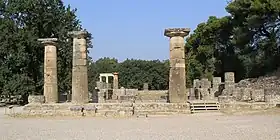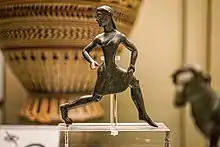The Heraea was an ancient Greek festival in which young girls competed in a footrace, possibly as a puberty or pre-nuptial initiation ritual. The race was held every four years at Olympia. The games were organised by a group of sixteen women, who were also responsible for weaving a peplos for Hera and arranging choral dances.
Overview

Not much is known about the Heraea, but most of our knowledge comes from Pausanias' Description of Greece.[1] The date that the festival began is uncertain. Pausanias says that the games are αρχαια (archaia, "old").[1] There is evidence for cult activity in Olympia as far back as the tenth century BC, but the earliest cultic activity at the site appears to centre around the cult of Zeus; the cult of Hera was certainly in place by about 600 BC, when the first temple of Hera at Olympia was built.[2] It is uncertain whether the races were an original feature of the festival, or a later addition.[2] One story in Pausanias associates the sixteen women responsible for the Heraea with the conflict between Elis and Pisa after the death of Damophon, tyrant of Pisa around 580 BC. If the festival were already established by this point, there may have been a re-organisation around this time (as there was at other Greek festivals in the late archaic period).[3]
The Heraea took place every four years. Some scholars have suggested that the games took place around the time of the ancient Olympics, but there is no ancient evidence for when the Heraea occurred and Donald G. Kyle argues that due to the ancient Greek custom of secluding women from unrelated males, the event was more likely entirely separate from the Olympics.[4]

The only event at the Heraean Games was the stadion,[5] which was one sixth shorter than the equivalent men's race.[6] Only parthenoi (unmarried young women) competed in the games.[7] Competitors raced in three different age categories,[8] though it is uncertain exactly how old the competitors were.[5] They wore a distinctive outfit of a short chiton cut above the knees, which left the right shoulder and breast bare, and wore their hair loose.[8] This outfit may have derived from the exomis, a variant of the chiton worn by labourers and associated with Hephaestus.[9] A Laconian statuette found in Epirus and now in the British Museum, dating to c. 560 BC, depicts a girl in the costume associated with the Heraean Games; this possibly suggests that unlike other ancient Greek races for girls, the Heraean Games were Panhellenic as early as the sixth century BC.[10]
The winners were awarded a crown of olive leaves and a portion of a cow which was sacrificed to Hera.[6] They were also permitted to dedicate statues inscribed with their name to Hera, though none of these statues survive.[6]

The festival of the Heraea was presided over by a group of sixteen women, who as well as conducting the games were responsible for weaving a peplos for Hera and arranging choral dances in honour of Hippodameia and Physcoa.[11] Pausanias gives two stories about these sixteen women. The first is that the Heraia was founded by Hippodamia and the first games were held to celebrate her marriage to Pelops, and she selected sixteen women to compete in the games. The second is that to settle a dispute between Elis and Pisa, the Eleans selected a wise elderly woman from each of sixteen polites in ancient Elis to settle the dispute; these women were also given the responsibility of organising the Heraea.[12]
The Heraean Games may have been puberty rites[8] or pre-nuptial rituals.[13] Matthew Dillon argues that as there were three different age categories for competitors, the ceremonies were unlikely to be associated with marriage.[8] On the other hand, the races were associated with a mythological wedding, and other races between girls in ancient Greece (such as a footrace in honour of Dionysos held at Sparta, also described by Pausanias) seem to have been associated with pre-nuptial initiations.[13]
References
Footnotes
- 1 2 Serwint 1993, p. 404.
- 1 2 Serwint 1993, p. 405.
- ↑ Serwint 1993, p. 406.
- ↑ Kyle 2013, p. 266.
- 1 2 Scanlon 2004.
- 1 2 3 Dillon 2002, p. 131.
- ↑ Case 2017, p. 29.
- 1 2 3 4 Dillon 2000, p. 460.
- ↑ Serwint 1993, pp. 416–417.
- ↑ Scanlon 2014, pp. 113, 126.
- ↑ Serwint 1993, pp. 419–420.
- ↑ Spears 1984, pp. 43–44.
- 1 2 Serwint 1993, p. 418.
Works cited
- Case, Mary Anne (2017). "Heterosexuality as a Factor in the Long History of Women's Sports". Law & Contemporary Problems. 80.
- Dillon, Matthew (2000). "Did Parthenoi Attend the Olympic Games? Girls and Women Competing, Spectating, and Carrying out Cult Roles at Greek Religious Festivals". Hermes. 128 (4).
- Dillon, Matthew (2002). Girls and Women in Classical Greek Religion. London: Routledge. ISBN 0415202728.
- Kyle, Donald G. (2013). "Greek Female Sport: Rites, Running, and Racing". In Christensen, Paul; Kyle, Donald G. (eds.). A Companion to Sport and Spectacle in Greek and Roman Antiquity.
- Scanlon, Thomas F. (6 April 2004). "Games for Girls". Archaeology. Archaeological Institute of America. Retrieved February 18, 2006.
- Scanlon, Thomas F. (2014). "Racing for Hera". In Scanlon, Thomas F. (ed.). Sport in the Greek and Roman Worlds. Vol. 2.
- Serwint, Nancy (1993). "The Female Athletic Costume at the Heraia and Prenuptial Initiation Rites". American Journal of Archaeology. 97 (3). doi:10.2307/506363. JSTOR 506363. S2CID 193022602.
- Spears, Betty (1984). "A Perspective of the History of Women's Sport in Ancient Greece". Journal of Sport History. 11 (2).
External links
![]() Media related to Heraean Games at Wikimedia Commons
Media related to Heraean Games at Wikimedia Commons